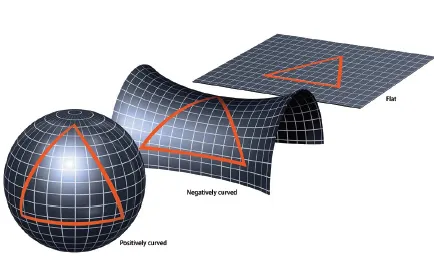The shape and geometry of the universe is determined by whether it will expand forever due to Big Bang or will eventually collapse due to gravity, and whether the extent of cosmos is finite or infinite. An ever-expanding universe will be open and infinite while as a Universe shrinking due to gravity will be closed and finite.
An obvious technique to discriminate between an open universe and a closed universe is to measure the average density of matter. The mathematical relations given by Alexander Friedmann describe the competition between the attractive gravitational force and the expansion of the universe within the context of general theory of relativity propounded by Einstein.
If the presently known density of matter is below the critical value at which the expansion and the gravitational attraction balance, then gravity cannot stop the expansion and the Universe must be open. The critical density for the closure of Universe is roughly 1.06 x 10-29 gm/cm3.
The boundary condition between these two assumptions of an open universe or a closed Universe is that the expansion of the universe may continue forever but it will also slow down due to attractive gravitational forces while asymptotically approaching to zero, such that it will not quite halt in a lasting stretch of time. This very special approximation leads to what we call a flat universe, and according to many cosmologists, it is currently the state of the universe in which we live.
The general theory of relativity, also allows for the universe to be of one of these three forms viz; open, closed or flat. However, this flatness is not like a usual understanding of two-dimensional sheet. It is rather envisioned with some different analogies.
In such a Universe, for example, two rockets flying adjacent to each other will always remain parallel and will never cross their paths. Some of the recent observations from Atacama Cosmology Telescope or ACT also show that there is no deviation from the flatness and universe is flat with a 0.04% margin of error in our estimates.
The only deviation to flatness is due to the sum of all the quantum fluctuations that may get stretched during the cosmic inflation itself. Based on our growing understanding of how these fluctuations work, we may lead to a novel prediction that has yet to be tested to sufficient precision.
The shape of the universe incorporates both its local and global geometry. We know that space itself is curved by mass. Much like a dip is created in a soft pillow with our head, so does the fabric of spacetime bend around the massive objects in space.
Therefore, local geometry is primarily defined by curvature. General relativity further explains how spatial curvature is constrained by gravity. The global topology is also constrained by curvature but it cannot be deduced from measurements of curvature alone, due to the existence of locally indistinguishable spaces with varying characteristics.
Right now, we have only measured the curvature to a level of 1-in-400 parts, and found that Universe is by and large, flat. Our observable Universe should, however, depart from perfect flatness at a level that’s between 1-part-in-10,000 and 1-part-in-1,000,000.
Therefore, if we could get down to these ultra-sensitive precisions, we would have the opportunity to confirm or refute the earlier predictions thereby leading to a better theory of our cosmic origins as never before.
Although the universe today appears indistinguishable from flat, it may yet turn out to have a tiny but meaningful amount of non-zero curvature because it isn’t perfectly flat, after all. But at least for now, the universe seems to be a three-dimensional sheet of paper which is neither wholly closed, nor wholly flat.
The measurements which show that the universe might be flat also suggest that it must be of infinite size, since it is also expanding. From the observations of exploding stars, including those from European Southern Observatory, ESO’s telescopes at La Silla and Paranal, the expansion of the Universe is found to be accelerating. In fact, the Nobel Prize of 2011 in Physics was awarded for this result.
One would also be highly interested in knowing what the edge of the universe looks like though for observing that, one has to step out of it which is not practically possible. However, on very large scales, the universe is considered to be homogenous and isotropic. Therefore, we may imagine a sample in the form of an arbitrary sphere cut out of the universe which may be small compared to the size of the universe, but quite large compared to the average distance between the galaxies.
The gravitational force exerted at the centre of such a sphere is proportional to the average density of matter. The measured value of the Hubble’s constant yields the kinetic energy of expansion of the sphere. If the universe as a whole is expanding, so will this region be also expanding, whereas if the universe re-collapses this region will also be shrinking.
Moreover, the speed of light limits our view of the volume of universe since the Big Bang happened only 13.8 billion years before and scientists can therefore only see 13.8 billion light-years from Earth. In other words, since our access to the observable universe is limited, we could be missing great details out there.
Dr. Qudsia Gani, Assistant Professor, Dept. of Physics, Govt. Degree College, Pattan Baramulla






